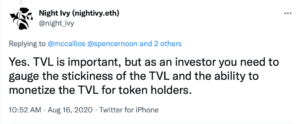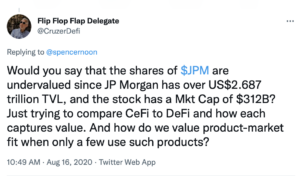Spencer Noon
7 Indicators for DeFi Project Investment
Originally published on Twitter on August 16, 2020
Read on to learn why each indicator matters and how to evaluate the strength of each one.
1. Total Value Locked / Fully-Diluted Market Cap
Here’s why: Protocols with more value locked should be able to capture more value.
Rule of thumb: ↑ number = better
DIY: DeFi Pulse & Coin Gecko
2. Price to Sales (aka Marketcap / Revenue)
Here’s why: DeFi protocols that sustainably capture revenue have better long-term prospects.
Rule of thumb: ↓ number = better
DIY: Token Terminal
3. % of Token Supply on Exchanges
Here’s why: Useful for understanding float dynamics (i.e. maximum sell pressure)
Rule of thumb: ↓ number = better
DIY: Nansen
4. User Growth (aka Unique Address Growth)
Here’s why: Useful indicator for determining product-market fit.
Rule of thumb: ↑ slope = better
DIY: Dune Analytics (start with this example dashboard)
5. Token Balance Change on Exchanges
Here’s why: When tokens move onto exchanges, there is a high likelihood of sell activity.
Rule of thumb: ↓ exchange balance = better
DIY: Nansen
6. Non-Speculative Usage
Here’s why: Looking at the number of daily transactions not related to speculation (trading) is a great way to understand how much a protocol is actually being used for its intended purpose.
Rule of thumb: ↑ number = better
DIY: no one-stop shop to view this yet!
7. Liquid Inflation Rate
Here’s why: investors should be aware of potential dilution and deeply understand a project’s token economic model
Rule of thumb: None – not all inflation is bad.
DIY: Messari Crypto
More Indicators
Here is some of the best additional feedback I’ve received about risks and other investment considerations.
A Grain of Salt
Finally, an important note: DeFi indicators are not one-size-fits-all. These indicators can be gamed (especially during bull markets).
If you want to learn more DeFi fundamentals, subscribe to my crypto analytics newsletter Our Network.



